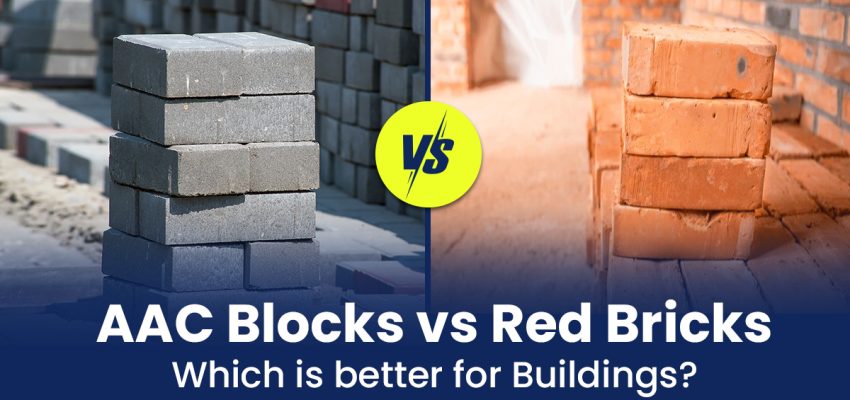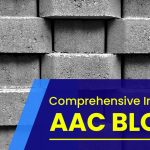Choosing between AAC blocks and red bricks for construction is a crucial decision. Red bricks have been a traditional choice due to their durability, affordability, and comfort. However, with growing demand, there’s a strain on resources like fertilizers, impacting costs and the environment.
Post your Requirement
In response, concrete blocks, particularly AAC blocks, emerged as an alternative. AAC, using fly ash, a by-product, addresses environmental concerns. It boasts high strength and durability, gaining recognition for its eco-friendly attributes. This shift represents a practical solution amid resource challenges and environmental considerations in construction. Here is our blog comparing AAC Blocks with Red bricks to help you decide which one of them is a better building material
What Are AAC Blocks?
Autoclaved Aerated Concrete (AAC) is a versatile, eco-friendly building material offering durability, insulation, and fire resistance. Comprising quartz sand, calcined gypsum, lime, portland cement, water, and aluminum powder, AAC products are cured under heat and pressure. Developed in the mid-1920s, AAC serves multiple construction purposes, including industrial and residential buildings. It is widely used for exterior and interior walls, firewalls, insulation boards, floors, roofs, stairs, and more. Its application extends to various structures like townhouses and apartments. AAC’s easy installation and adaptability on-site, allowing routing and cutting, make it a preferred choice. Its resistance to fire and mold ensures long-lasting, low-maintenance structures.
What Are Red Bricks?
Bricks, traditionally made of clay, are vital in masonry construction for walls and pavements. Modernly, the term extends to units of various materials. Blocks, larger rectangular units of clay or concrete, include lightweight versions like expanded clay aggregate. Dating back to 4000 BC, fired bricks endure as robust, long-lasting building materials, forming sturdy structures with diverse patterns and bonds in various mortars.
Comparing AAC Blocks And Red Bricks
Below we have compared AAC Blocks and Red Bricks on various parameters:
- Compressive Strength: AAC blocks are stronger (3-4.5 N/mm²) than red bricks (2.5-3.5 N/mm²).
- Durability: AAC blocks are more durable, strengthen structures, and require less maintenance than fragile red bricks.
- Utility: AAC blocks are lightweight, increasing carpet area, while red bricks are heavy and bulky.
- Workability: AAC blocks are lighter, requiring less labor and mortar, speeding up construction compared to red bricks.
- Sustainability: AAC blocks, made with fly ash, are eco-friendly, while red bricks deplete topsoil, impacting the environment.
Notable Features:
- Lightweight: AAC blocks are 3-4 times lighter, cost-effective, and easy to transport.
- Fire Resistance: AAC blocks offer up to 4 hours compared to red bricks’ 2 hours.
- Sound Insulation: AAC blocks provide better sound insulation (42 dB) than red bricks.
- Thermal Insulation: AAC blocks contribute to HVAC cost savings, unlike red bricks with minimal insulation.
- Earthquake Resistance: AAC blocks are designed for seismic resistance, ideal for construction.
- Pest Resistance: AAC blocks resist termites, lowering long-term maintenance costs compared to red bricks.
- Water Penetration: AAC blocks absorb 10% water, ideal for construction, unlike water-absorbing red bricks.
- Storage: AAC blocks are available year-round without special storage, unlike red bricks susceptible to damage during the rainy season.
Top Brands Selling AAC Blocks
We have mentioned below the list of some noteworthy AAC Block Brands:
Conclusion
AAC blocks, eco-friendly and durable, offer advantages over red bricks regarding sustainability, performance, and overall construction efficiency. Consider these factors to make an informed choice for your construction projects.
FAQs
Q-1. Are AAC blocks costlier than red bricks?
A-1. Initially, AAC blocks may seem costlier, but considering reduced labor and mortar costs, they can be more economical.
Q-2. Can AAC blocks be used for all types of construction?
A-2. Yes, AAC blocks are versatile and suitable for various constructions, including residential, commercial, and industrial buildings.
Q-3. Is AAC block good for home?
A-3. Yes, AAC blocks are excellent for homes. They offer durability, energy efficiency, fire resistance, and faster construction. Their lightweight nature makes them easy to handle, contributing to overall construction efficiency.
Q-4. How do you repair a cracked AAC block wall?
A-4. To repair a cracked AAC block wall, use a crack-filling mortar designed for AAC blocks. Apply the mortar to fill cracks and plaster. This specialized solution ensures effective repair and structural integrity.
Q-5. Do AAC blocks require plastering?
A-5. With their wire-cut and plain surface, AAC blocks don’t necessarily require plastering. However, for the external side, plastering might be needed for aesthetic or protective reasons. Design preferences and specific project requirements can influence the decision.


















Post A Comment